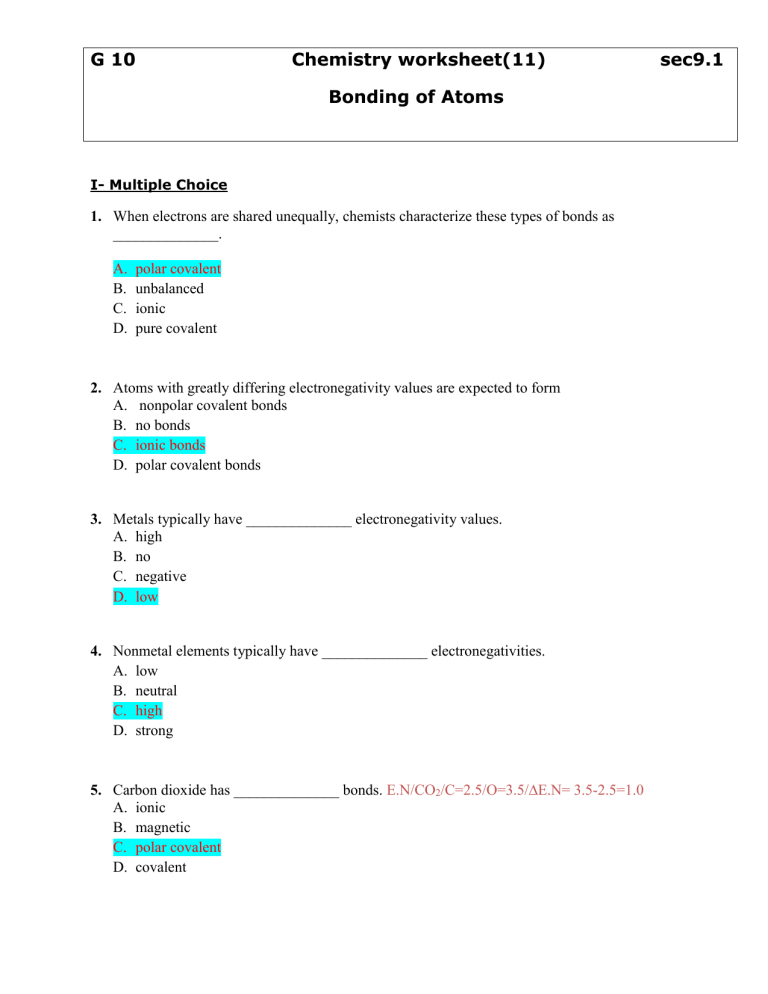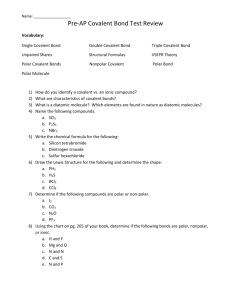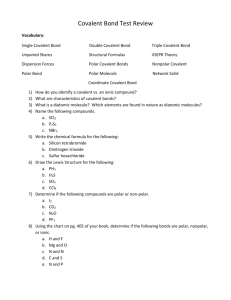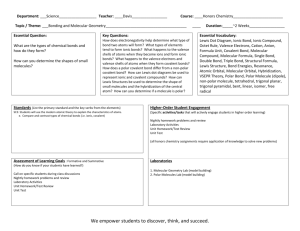Answer Key for worksheet 9.1

G 10 Chemistry worksheet(11) sec9.1
Bonding of Atoms
I- Multiple Choice
1.
When electrons are shared unequally, chemists characterize these types of bonds as
______________.
A.
polar covalent
B.
unbalanced
C.
ionic
D.
pure covalent
2.
Atoms with greatly differing electronegativity values are expected to form
A.
nonpolar covalent bonds
B.
no bonds
C.
ionic bonds
D.
polar covalent bonds
3.
Metals typically have ______________ electronegativity values.
A.
high
B.
no
C.
negative
D.
low
4.
Nonmetal elements typically have ______________ electronegativities.
A.
low
B.
neutral
C.
high
D.
strong
5.
Carbon dioxide has ______________ bonds. E.N/CO
2
/C=2.5/O=3.5/∆E.N= 3.5-2.5=1.0
A.
ionic
B.
magnetic
C.
polar covalent
D.
covalent
8.
6.
Which of the following compounds contains an ionic bond?
A.
NaCl C. CCl
4
B.
O
2
D. SO
2
7.
The most electronegative element is _____
A.
Cs C. F
B.
He D. At
In the hydrogen chloride molecule, the atoms are held together by a(n) E.N/H=2.1/Cl=3.0/=0.9
A.
polar covalent bond
B.
double bond
C.
nonpolar bond
D.
ionic bond
9.
If atom X forms a diatomic molecule with itself, the bond is
A.
ionic
B.
nonpolar covalent
C.
polar covalent
D.
polar coordinate covalent
10.
One of the most important characteristics of the water molecule is its ______________, which allows it to surround and attract both positive and negative ions.
A.
fluidity C. stability
B.
strength D. polarity
11.
A substance that has atoms held together by covalent bonds rather than ionic bonds is known as:
A.
Ionic compound C. Covalent compound
B.
Molecular substance D. Polar covalent compound
12.
A bond formed between two atoms with an electronegativity difference of 0.7 is likely to be :
A.
Polar covalent bond
B.
Nonpolar covalent bond
C.
Ionic bond
D.
Covalent bond
II- Answer the following Questions
1.
Tick each statement with the type of the bond that is related to it.
Metallic
Bond
Covalent
Bond
^^ A material used in making electrical transmission wires
^^ A material used to make the insulation wrapped around transmission lines that lie on the ocean floor
A material used as a lubricating oil ^^
Ionic
Bond
^^ A material that is dissolved in large quantities in sea water
A material used to make high-temperature furnaces
A material used in the manufacture of wires in suspension bridges
^^
^^
A material used to make cans ^^
A material used as a gaseous propellant in spray cans, such as deodorant or shaving cream dispensers
^^
A material that evaporates readily at room temperature ^^
A material that is a good conductor when melted but a poor conductor when solid
^^
2.
The line in below represents the range of differences in electronegativity ∆EN that are possible between any two elements in the periodic table. The smallest difference is represented by the left end of the line, and the greatest difference by the right end of the line.
In the space provided, write the letter of the labeled parts from this line that corresponds to the descriptions. Some of the letters may be used more than once.
a.
The lowest possible value of ∆ EN a b.
The bond of greatest possible ionic character g c.
A pure nonpolar covalent bond a d.
A polar covalent bond d e.
An ionic bond that would form between calcium and oxygen f f.
The bond in a diatomic molecule of an element a g.
A bond that is classified as nonpolar but that has a slight polarity b h.
The division between nonpolar covalent and polar covalent bonds c
3.
Using EN to classify the bonds in the following compounds as covalent, polar covalent, or ionic.
A) H S bond in H
2
S -> ∆EN=2.5-2.1=0.4 => covalent bond
B) S O bond in SO
2
->∆EN=3.5-2.5=1=> polar covalent bond
C) Mg Br bond in MgBr
2
->∆EN=2.8-1.2=1.7=>polar covalent bond
D) N O bond in NO
2
->∆EN=3.5-3.0=0.5=>polar covalent bond
E) C Cl bond in CCl
4
->∆EN=3.0-2.5=0.5=>polar covalent bond
4.
Electronegativity is a periodic property. i) Define electronegativity.
Electronegativity is a measure of the ability for an atom in a bond to attract electrons. ii) Explain what happen to the electronegativity of the elements as you move down from the top to the bottom of the group.
Electronegativity decreases as we go down a group. iii) Explain the relationship between shielding effect and electronegativity as you move down the group
The E.N decreases down the group because more energy levels are added. The attraction between the nucleus and the valence electrons decreases ( less attraction between nucleus and the valence electrons). The valence electrons because farther from the nucleus and less bonded to it. This is known as shielding effect
5.
List three properties of Metals
Good conductors of electricity.
Malleable.
Ductile.
6.
Explain why metals are good conductors of electricity
Metals are good conductors of electricity because the electrons can flow easily through a material to produce an electric current and the valence electrons of the metals are loosely held and free to move.







